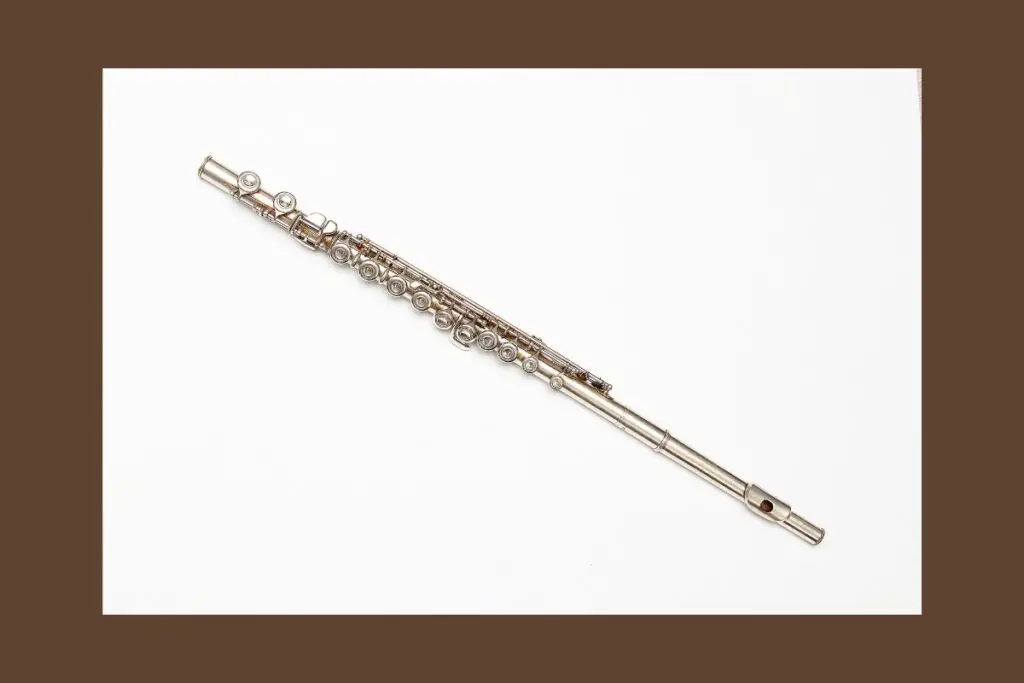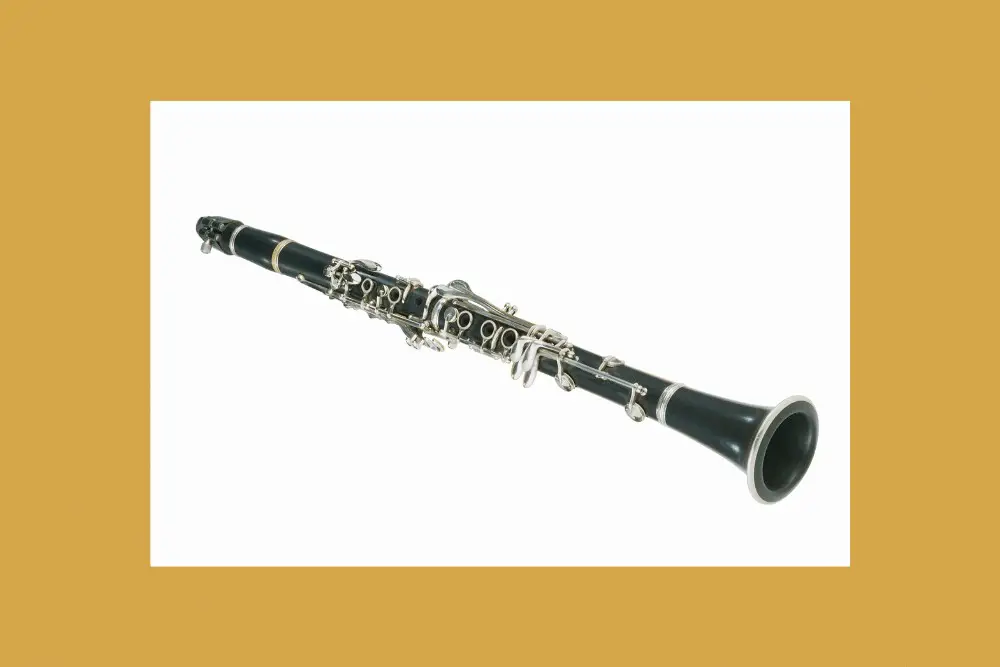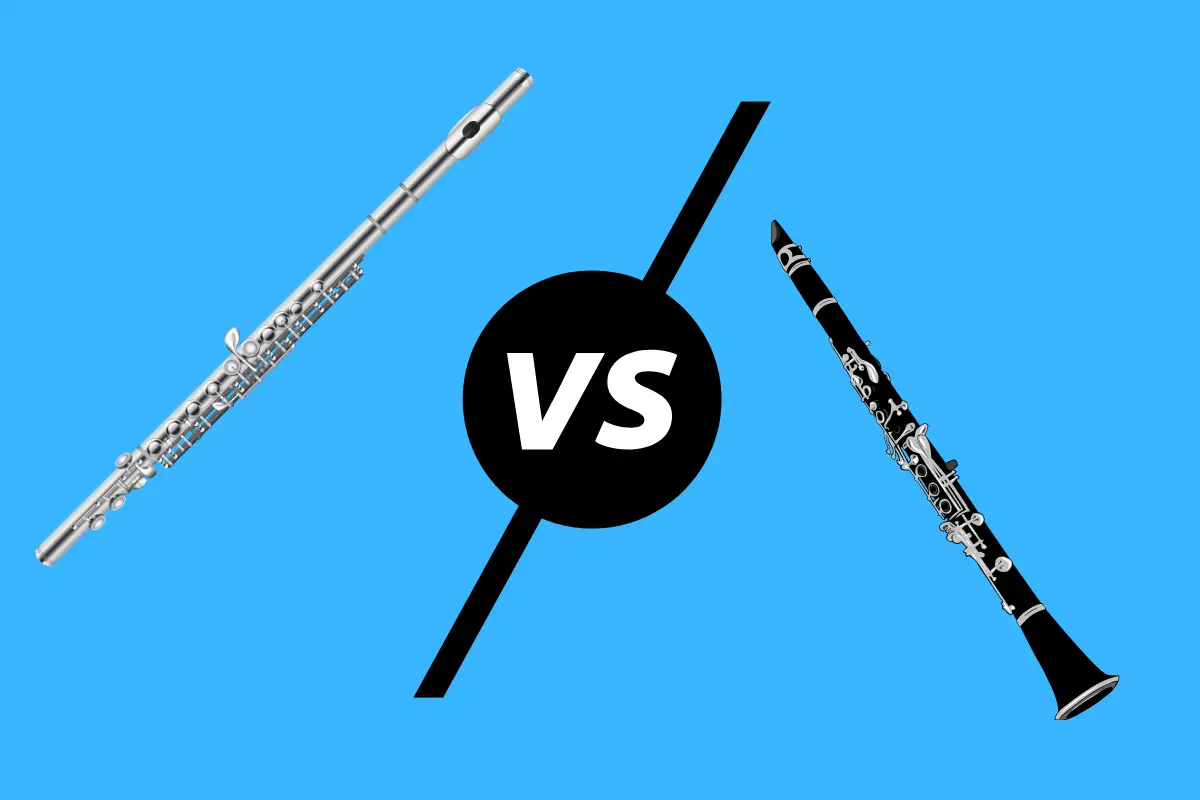People and students are always wondering which instrument they should learn to play, and often they have it narrowed down to two choices, such as the flute vs. clarinet.
As a music teacher with over a decade of experience helping people choose the instrument they’d like to play, I love to tackle comparison questions like this.
The flute and clarinet are in the woodwind family, change pitches the same way, and play a similar role in ensembles, but this is where the similarities end. The flute has an airy, light, higher sound with a metal body than the clarinet with its mellow, rich, lower register tone from its wood or plastic body.
Let’s look ahead for more details and figure which one may be right for you.
Table of Contents
Flute Vs. Clarinet: Direct Comparison
Here’s a handy table for a quick look at the essential specs on these wind instruments.
| Quality | Concert Flute | Clarinet in Bb |
|---|---|---|
| Instrument Family | Woodwind Family | Woodwind family |
| Sound creation | Air splitting as you blow over the embouchure hole toward the lip plate | Vibrating reed on the clarinet mouthpiece |
| Where is it found? | Everywhere | Everywhere but most commonly: Band, Jazz, Orchestra |
| Voice (Range) | Soprano (C4-C7) | Soprano (D3-Bb6) |
| Number of Keys | 16 | 17 |
| Length Of Tubing | 26 inc (67 cm) | 26 in (67 cm) |
| Average Cost For Intermediate Level Instrument* | $2,000 | $2,500 |
| Typical Role in Ensembles | Melody or ornamentation | Melody or ornamentation |
| Other types of | Piccolo, Soprano, Alto, Bass | Bb Clarinet, A clarinet, Bass clarinet, Eb clarinet |
| When was it invented? | 1285 | Approximately 1700 |
| General sound description | Light, airy, pure | Rich, mellow, soothing |
| How To Change Pitch | Pressing keys covers and uncovers the tone holes changing the vibration frequency (Hz) | Pressing keys covers and uncovers the tone holes changing the vibration frequency (Hz) |
| Material | Typically made of silver | Typically plastic for lower-end and wood for higher-end |
Note: Today’s detailed comparison will cover the concert or soprano flute (also called the C flute) and the Bb clarinet.
Both instruments have different types of each, though these two are the most common you’ll see.
You may also want to check out our article on the different types of flutes.
Differences Between The Flute And Clarinet
First, we should look at the difference. In this section, you’ll also find images and listening examples to draw comparisons for yourself.
Visuals/Looks
While having several similarities, including being a similar length, they are wildly different in looks.

The flute is held sideways with a body made of metal, often silver in material and color.
It’s covered in keys which help cover the many tone holes.
The flute has an open hole on the end, and another on the top of the instrument called the embouchure hole.
From tip to end, the flute is typically around 26 inches (67 cm).
Its made from three parts: the head joint, the middle joint, and the foot joint.

A clarinet is usually made of plastic (in lower-end models) and wood, usually black or dark brown.
Keys go up and down the body to help cover the tone holes.
At the top is a mouthpiece with a ligature to hold the single, typically wooden, reed where you blow.
It goes down one long tube and opens into a small flared bell.
From tip to end, the clarinet is around 26 inches (67 cm) long.
Its made from 5 parts: the mouthpiece, the barrel, the upper tube, the lower tube, and the bell.
Range
At first glance, the ranges appear to be quite similar.
The flute plays from C4-C7, while the clarinet has a range of D3-Bb6.
Both are in the soprano range of the ensemble, but it’s the practical range of each which is quite different.
They do overlap quite a bit, but they aren’t always equally strong.
The clarinet plays a minor seventh lower than the flute (almost a whole octave) for its lowest note, but it reaches up almost as high.
The clarinet’s highest note is only a major second (one whole step) lower than the flute’s highest.
However, the flute has a much more consistently pleasant and mellow tone at those higher ranges.
In most music writing, the clarinet won’t play this high, and it’s left to the flute.
By the same token, the flute does play all the way down to C4 (middle C on the piano), but the flute sound is weaker and airier in the low range.
Learn more about the range of the flute.
Sound Production
Musical instruments are defined by how they make their sound. It’s the main quality you use to group them into families.
And while these two wind instruments both belong to the woodwind family, they don’t make sound waves the same way.
For the flute, you aim a focused air column across the embouchure hole toward the lip plate.
When the air hits the plate, it’s split. This splitting causing vibration, creating sound.
The vibrations are then amplified, changed in timbre, and altered to a specific pitch by the flute’s body and fingerings.
The clarinet, on the other hand, is a single-reed instrument.
A clarinet player blows on the mouthpiece which holds the wooden reed. For this one, the clarinet embouchure focuses on a tight mouth for creating a good tone.
As you blow, the reed vibrates a small distance at fast speeds. This is the vibration of the air which creates sound.
The vibration travels through the clarinet tube or body, getting louder and changing pitch according to the fingerings and force of the air behind the sound.
Tone
The flute and clarinet’s tones are quite different from one another, and this is directly due to the difference in how they create their sound.
(This is also why a brass instrument will sound similar to other brass instruments; they make their sound in the same way).
There are a number of adjectives out there people use for each one, but you should listen and decide for yourself.
These are two professionals playing a concerto written for their instrument by Mozart on these popular instruments.
When I hear the flute, I think light, airy, pure.
When I hear the clarinet, I think rich, mellow, soothing.
Fingering
The function of how each of these instruments changes the notes is similar, but the number of keys and how they work is a little different.
Honestly, it’s possible to fit this quality into both similarity and difference at the same time!
Both instruments use keys to help cover the tone holes to change the notes, but the flute has 16 while the clarinet typically has 17.
On top of this, the clarinet also has a number of keys which feature finger holes.
The finger holes are when, as you press the key, your finger is also covering up an open hole.
In one of the clarinet’s registers, the fingerings are the same as the flute, but when you press the back register key, everything gets different from there.
It’s a complicated fingering system for most to learn right away.
Similarities Between The Flute And Clarinet
Now, let’s dive into the similarities between the two instruments. There aren’t many, and most players won’t switch between the two interchangeably.
Instrument Family
First, both instruments are clearly woodwind instruments—they are both in the same family and grouping.
Short version explanation for why: if the instruments use a column of splitting air or a wooden reed, they are both in the woodwind family.
Slightly lengthier, but still not huge, explanation:
The woodwind family gets this name because its instruments were typically made from wood back in the early days of those instruments.
They were grouped together because of the clear difference in sound production from a brass instrument, string instrument, and percussion instrument.
They also have a similar tone compared to other instruments and fit together well.
The common members of the woodwind family are:
- Flute
- Clarinet
- Alto Saxophone
- Oboe
- English Horn
- Bassoon
All the instruments on this list, except the flute, use a reed. The oboe, English horn, and bassoon are double reed instruments, which means they use two pieces of reed stuck together instead of one, like the clarinet and saxophone.
Changing Pitches
Though what the fingerings look like and how they are shaped are different, the function of changing pitches is the same.
Cover up more tone holes by pressing keys, and the notes will change.
Flute players have a bit more control over the pitch by tilting the flute away or toward them a little bit.
Clarinet players have some control with their embouchure shape, but not as much.
All woodwind instruments follow this same general rule:
The more keys you press down, the lower the pitch goes.
Compared to other families, even the brass, which also uses their fingers, has a similar function and method for changing notes.
Role In Ensembles
Both of these beautiful instruments serve a similar function in their groups, whether you’re playing in the orchestra, jazz, band, or small group.
Both are considered melody instruments. They almost always get some form or part in the melodic lines.
This is less so with the orchestra when they’re regulated a bit more to their secondary purpose and a flourish or enhancement instrument.
Either way, both of these are often seen playing soaring, long, and beautiful lines while also fluttering around with quick and fast passages.
In schools, both are equally popular instruments, with perhaps a slight edge to the flute.
You’ll find both in:
- Orchestral music
- Concert band; marching band
- Contemporary music
- Jazz music
- Popular music
- Small ensembles
- And much more
Should I Play Flute Or Clarinet?
There are a number of factors to consider before picking one of these to play. Let’s look at all of them to help you decide which is right for you.
Preference/Desire
I always start with this element, and I know I tend to rant on this topic.
The more interested you are in learning an instrument, the more likely you are to succeed.
It doesn’t matter if you have the right mouth shape for one or the other. It doesn’t matter if you are someone who doesn’t like really difficult challenges.
If you love the sound of the modern clarinet, play it.
If you have an older uncle who played the flute, and this makes you want to learn it too, play it.
I’ve been around the music biz long enough to know: desire is one of, if not the most important factors for long-term success.
If someone tries to convince you to play a different one and you don’t want to, be firm. Play the one you want.
If you don’t care too much one way or the other, use these other elements.
Difficulty
In general, but not always, the clarinet is considered easier to learn than the flute.
This is due to the difficulty of the flute in making the sound. At first, it’ll be tough to aim the air at the exact correct spot to make a good sound consistently.
The clarinet is a bit more direct and simple in its sound production at first.
Again, this is a general rule.
Down the line, the sheet music is equally difficult, as is the fingerings (with the flute’s being a tiny bit easier).
It’s a personal thing too. See if you can get your hands on the instruments to try them out first.
This will give you a better idea of which one is more natural to you.
If you want a challenge, go for the flute! If you’re afraid of the challenge (we don’t have all the time in the world), go for the clarinet.
Lip Shape
Normally, I hate talking about lip shape when it comes to instruments.
If you want to learn the instrument, forget about your lip shape. It may make it harder or easier to play certain instruments, but it’s not a huge difference.
With the flute, I wanted to bring up the idea of this teardrop embouchure.
This is when the middle of your upper lip dips down farther than the rest of your upper lip by quite a bit.
It’s not an uncommon condition, and most people won’t even think about it or realize it in normal life.
But for flute playing, this dip makes it much harder to play.
If you find your upper lip dips down a lot, you may want to consider another instrument.
It’s not impossible to get around this, but it will take a lot of practice and adjustment from the typical flute positioning.
Price
At every level of instrument, beginner, intermediate, advanced, and professional, the flute and clarinet are very close to the same price range.
This likely won’t be a huge deciding factor for you.
However, there is a slight edge to the flute in terms of price. It’s usually a bit more affordable, and they are usually more durable too.
Availability
By the same token, if you have access to a flute or clarinet from a cousin, parent, grandparent, friend, or other family members, make a deal with them and buy this instrument used.
Make sure it’s a good model and is in good working condition, but you may want to consider these too before you commit to an instrument.
You may also want to check out these comparisons:
FAQ
Is it easier to play the flute or clarinet? – At first, the clarinet is easier to play than the flute due to the difficulty in making the sound on a flute.
In the long run, they’re the same level of difficulty.
What’s the easiest band instrument to play? – The easiest band instrument to play, at first, is the trumpet. Sound production is simple and easy.
In the long run, it gets more difficult, especially with the high range and faster passages.
Can flute players switch to clarinet (and vice versa)? – Flute and clarinet players can switch back and forth between the instruments, but it’s not an easy switch.
The methods for making sound are so different; it’s like learning the instrument all over again.
The saxophone and clarinet are much easier to switch between as they’re both single-reed instruments.
What is the hardest wind instrument to play? – The hardest wind instrument to play is considered either the oboe or the french horn.
This is, of course, largely subjective, but the oboe is difficult to get a good tone on and deal with the air pressure (called backpressure) coming at your head.
The french horn plays with close partials, meaning you’ll often miss notes. Even high-quality players will miss notes on the french horn occasionally.

